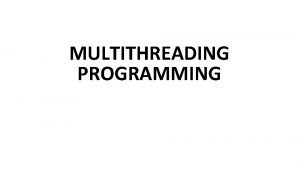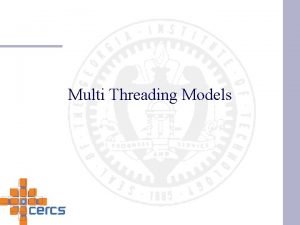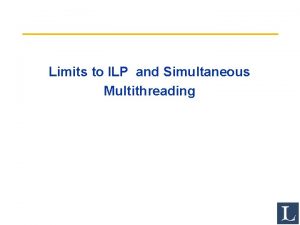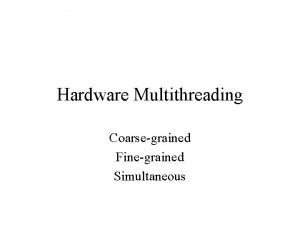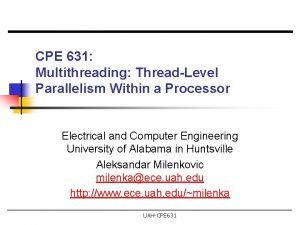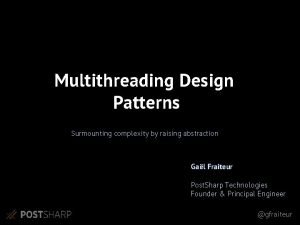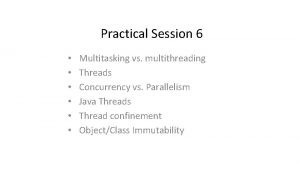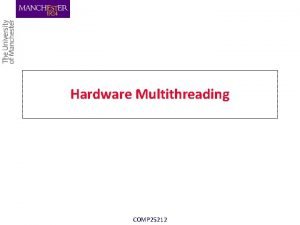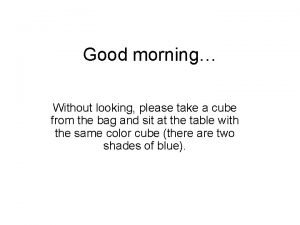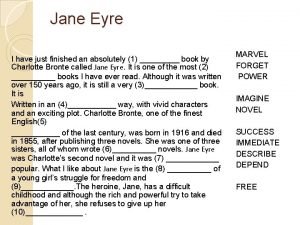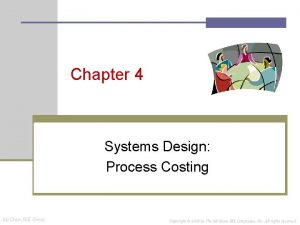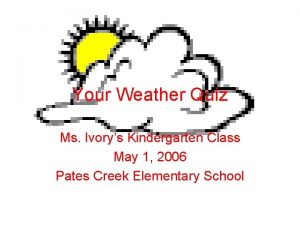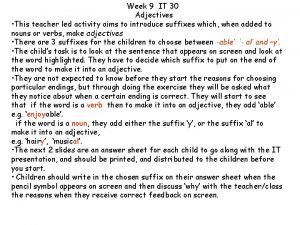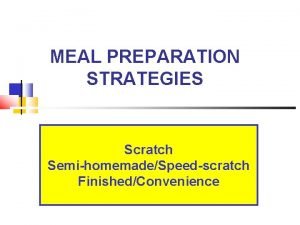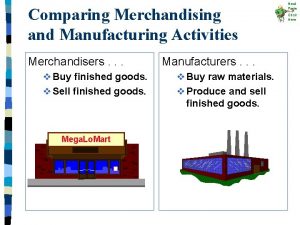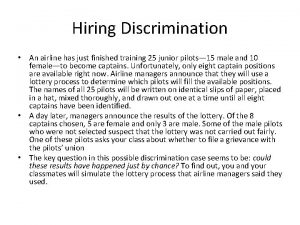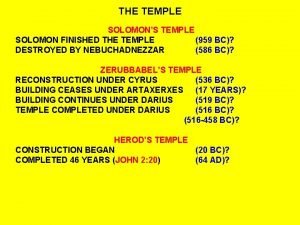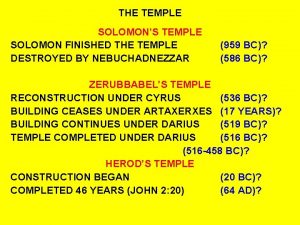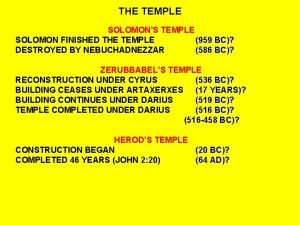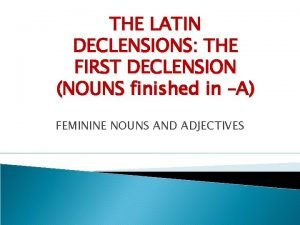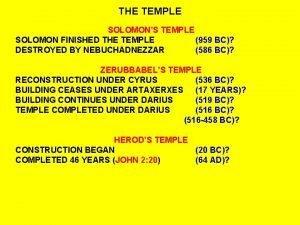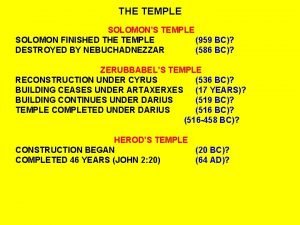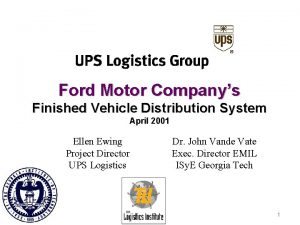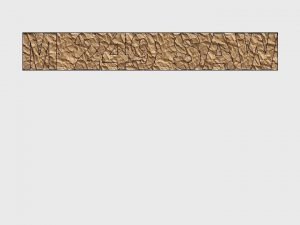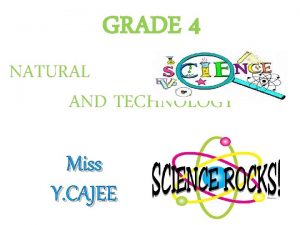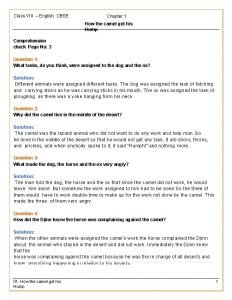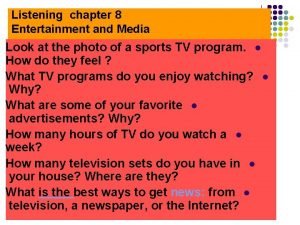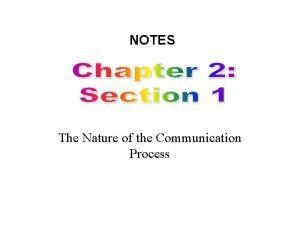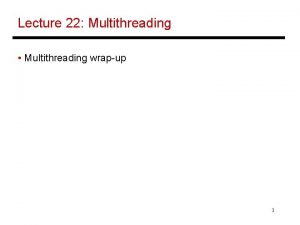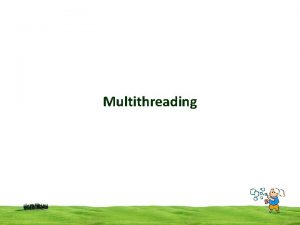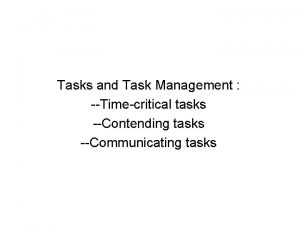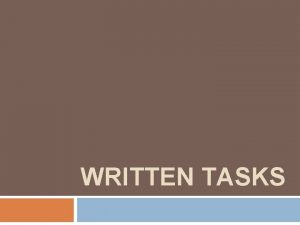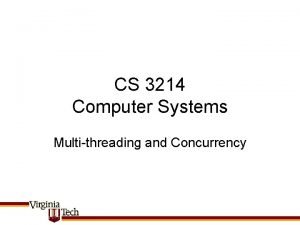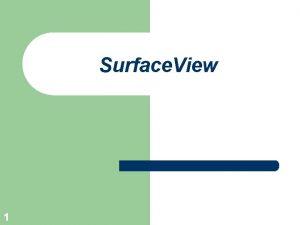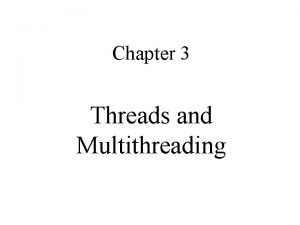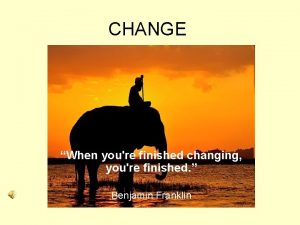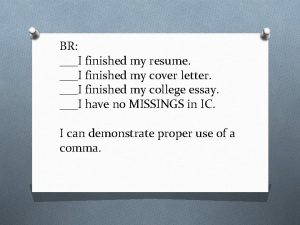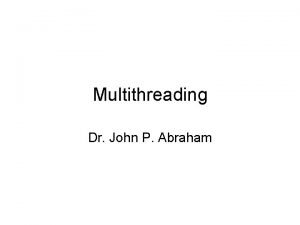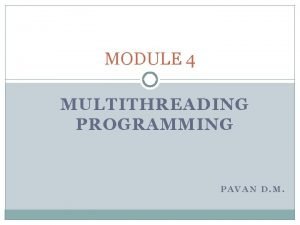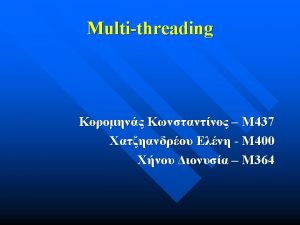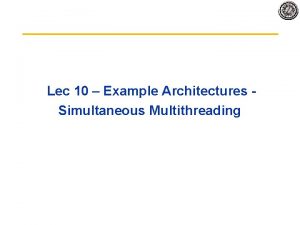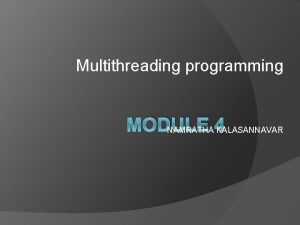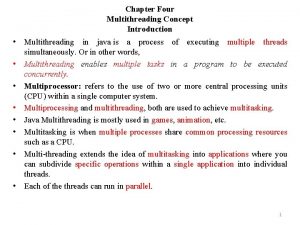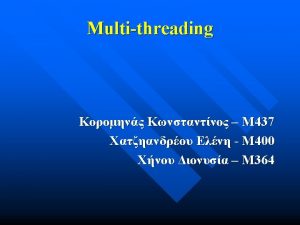Last lecture finished discussion on tasks and multithreading


























































- Slides: 58

Last lecture • finished discussion on tasks and multithreading • important part of event driven and visual programming • to remain responsive • the task parallel library • Parallel. Invoke, Foreach • loop counter, break, stop, per-thread counter • concurrent collections, stack, queue, bag, dictionary • ended with a producer consumer queue with tasks

Now • discuss event driven programming on the web and mobile • client side programming and eventhandling • server side web programming in other courses

• static web sites initially • html. . . hypertext markup language • display information and thats it • today websites reach interactivity of desktop applications. . . cuz of Java. Script • animation, interactivity, dynamic visual effects • e. g. immediately give err msg when wrong data, give total when add to shopping cart, slideshow instead of image list, expand collapse information, popup tooltips • immediate feedback. . . no delay like server side • no constant loading reloading. . . so feel like desktop programs

• e. g. you visited google maps. . . JS in action • zoom in zoom out • prev. map sites used reloading

history • 95 by netscape. . . about as old as web • but mostly hobby things like flies with mouse or messages that move like stock ticker • many scripts but din work in all browsers, even crashed them often • JS has nothing to do with Java, originally named Live. Script but renamed to associate with then hot Java • initial interoperability problems in netscape and IE • often added incompatible features • MS introduced j. Script. . . their version of JS for IE • these days mostly handled. . . standardization. . . some quirks left. . . called ECMAScript. . . the official standardization name. . . • refueled by high profile sites like google using JS in last decade • now JS even used by some non-web scripting. . . even flash Action. Script based on it. . . or write widgets, phone apps etc.

j. Query • JS is a prog language. . . can be hard for some. . . also browser incompatibilities make testing difficult • j. Query is a JS library intended to make JS programming easier • j. Query soles JS complexity and browser incompatibilities • can do things in single LOC that would take hundreds • many advanced features come as j. Query plugins • used on millions of websites

HTML, CSS, JS • HTML: structural layer • CSS: presentation layer • JS: behavioral layer

HTML . • simple commands called tags • doctype is of html 5 here. . . tells browser how to render the page. . . what standards • five types of html in use: HTML 4. 01 Transitional, HTML 4. 01 Strict, XHTML 1. 0 Transitional, XHTML 1. 0 Strict, and HTML 5 • all current browsers understand ’em all • starting and closing tags like XML • at least three tags. . . html root tag, head tag containing title etc, and body tag containing all parts to be rendered in browser window • <p></p> is paragraph <strong></strong> is emphasis <a href=“http: . . . ”></a> is a hyperlink. . . XML attribute and value • validating html means checking if all tags appropriately closed etc.

CSS • originally only HTML • CSS is a formatting language • html only to structure, so <h 1> <h 2> are both headings with diff imp <ul> is an unordered list • CSS adds design. . . CSS style is a rule telling web browser how to display an element • e. g. you can make CSS rule to make all <h 1> tags 36 px tall, in courier font, and in orange • CSS can do more powerful stuff, like add border, change margins, and even control exact placement on web page • JS can add/remove/change CSS properties based on input or mouse clicks. . . even animate from one property to another. . . like yellow to red. . . or animate across screen by changing position

a single CSS style • a rule that tells how to format. . . make “this” look like “that”. . . selector and declaration block • e. g. selector can be headline, paragraph of text, photo etc. • declaration block can turn text blue, add red border around a paragraph, position the photo at center of page etc. • e. g. p { color: red; font-size: 1. 5 em; } • selector, declaration block has declarations. . . each is a property value pair and then ;

• JS lets a page re-act • smart web forms. . . lets user know when they miss important info, make elements appear or disappear, or move around a webpage. . . even load new content from web server without reloading • more engaging and effective web sites

client side vs server side • prog lang for the web browser • alternate is a server prog lang. . . php, . net, asp, cold fusion, ruby on rails, etc. • they run on web server • log of intelligence by accessing DB, process CC, send emails • visitors wait until • client side lang can re-act immediately • responsive • other client side technologies are applets, silverlight, flash. . . often requires a plugin or start slow cuz of downloading • sometimes even diff to see if flash or JS. . . once yahoo maps was flash. . . then re-written. . . right click and see if About the Flash Player • Ajax brings client-side server-side together. . . JS talks to server, downloads content, and update webpage. . . google maps lets you move to new areas • JS is a prog lang and can be used on server side. . . e. g. Node. js supports JS on server-side

• discuss compiled vs scripted languages (interpreted) • JS interpreter is in web browser • lets write a prog to ask visitor name, get response, and print a welcome msg • web browser has layout or rendering engine (understanding HTML and CSS) and a JS interpreter • tell web browser about JS in a <script></script> tag

script in html 4. 01 and in html 5

• usually in head section and at one place. . . but its ok to put it anywhere and in multiple tags. . . • script can also be placed after </body> so script loaded after page displayed • can also use external script files. . . easy to share

• separate tags if you want inline code AND “src” attrib for external file • can and often use multiple external files

open hello. html in browser

• before the web page because of placement • web page appears after OK pressed • use document. write and <script> tag anywhere

• lot of basic syntax like C++, C# • create a variable using “var x”, names begin with letter, $, or _ • var days = ['Mon', 'Tues', 'Wed', 'Thurs', 'Fri', 'Sat', 'Sun']; • alert(days[0]); • var play. List = []; • var prefs = [1, 223, 'www. oreilly. com', false]; • prefs. push('test'); prefs. push('test', ’test 2’); . . . arrays grow • prefs. unshift('test'); prefs. unshift('test', ’test 2’); . . . insert at start • shift() gets/removes the first element. . . queue using push/shift • pop() removes last. . . stack • alert and prompt functions

• if, while, for, dowhile like C# • function declarations. . . no types • return value

j. Query • many JS programs select elements, add new content, hide and show content, modify tag’s attributes, determine value of form fields, and react to user actions • the details complicated specially with browser interoperability • libraries offer a set of functions to make these tasks easy

• only 30 k compressed library size • easy to learn • used on millions of sites • free • dev community • plugins. . . !!!

where to get j. Query. js • CDNs. . . dont need to host your own • often cached • google one is v popular. . .

• second script tag for j. Query prog • $(document). ready() waits until HTML of webpage loads and then runs the function • browser processes in order and to work with elements you want them downloaded • shortcut for ready function

• dynamically changing webpage is key idea • mouse over, click, detail info • e. g. date picker is run by JS but itself is made of HTML / CSS • JS just makes presentation interactive

• two steps. . . select sth, do sth with it • do sth. . • change prop • add/remove element • extra info • add/remove class attrib • or a combination of these

DOM . • much like an XML DOM • JS provides ways to select • e. g. • some browsers allow selecting by CSS • sometimes not cross browser

• to select <a> tags with class nav. Button, you have to select all <a> tags, then iterate and find the ones with the right class • in j. Query $(‘selector’) e. g. • $(‘#banner’) is the tag with id banner • $('#banner'). html('<h 1>Java. Script was here</h 1>'); • html is a j. Query helper function

basic selectors • ID selectors • element selectors • class selectors

advanced selectors • descendent selectors • $('#nav. Bar a') • child selectors • $('body > p') • adjacent sibling • $('h 2 + div') • attribute selectors • $('img[alt]') • $('input[type="text"]') • $('a[href^="mailto: "]') • $('a[href$=". pdf"]') • $('a[href*="missingmanuals. com"]') • form element selectors later

j. Query filters • : even : odd • $('. striped tr: even') • : first : last • : not • $('a: not(. nav. Button)'); • : has • $('li: has(a)') --- diff from descendent • : contains • $('a: contains(Click Me!)') • : hidden : visible • $('div: hidden'). show();

j. Query selection • don’t end up with DOM lists. . . rather j. Query equivalents • automatic loops. . . • $('#slideshow img'). hide(); • chaining functions. . . • $('#pop. Up'). width(300). height(300); • $('#pop. Up'). width(300). height(300). text('Hi!'). fade. In(1 000); • lets see j. Query functions to add content

• take this example • . html() can read and change • alert($('#errors'). html()); will show “<h 2>Errors: </h 2>” • $('#errors'). html('<p>There are four errors in this form</p>'); • . text() wont replace tags • $('#errors h 2'). text('No errors found'); • encodes html tags to. text() so <p> would become <p> • . append(). . prepend() • $('#errors'). append('<p>There are four errors in this form</p>');

• . before(). after() • <input type="text" name="user. Name" id="user. Name"> • $('#user. Name'). after('<span class="error">User name required</span>'); • <input type="text" name="user. Name" id="user. Name"> <span class="error">User name required</span> • . remove() • $('#popup'). remove(); • . replace. With() • $('#product 101'). replace. With(<p>Added to cart</p>');

attributes • add. Class remove. Class toggle. Class • css • var bg. Color = $('#main'). css('backgroundcolor'); • $('body'). css('font-size', '200%'); • $('p. highlight'). css('border', '1 px solid black');

multiple css props • use obj literal • chaining n obj lit perf

changing html attrib • css and add. Class are just shortcuts • general purpose attr() and remove. Attr() • var image. File = $('#banner img'). attr('src'); • $('#banner img'). attr('src', 'images/new. Image. png'); • $('body'). remove. Attr('bg. Color');

acting on each element in a selection • when you do want something special • each() and anonymous function • use “this” for current element as DOM obj • $(this) for current element as j. Query selection

events. . . • things happen to webpage. . . page loading, mouse move, key press • you respond to events • mouse events: click, dblclick, mousedown, mouseup, mouseover, mouseout, mousemove • doc/window events: load, resize, scroll, unload • form events: submit, reset, change, focus, blur • keyboard: keypress (over n over), keydown, keyup

• step 1: select elements • step 2: assign an event • step 3: pass function to event • $('#menu'). mouseover(function() { $('#submenu'). show(); }); // end mouseover


• ready() vs. load event • $(function() { • // do something on document ready • });

jquery events • hover • toggle is like hover except worked on and off by clicks • event object is passed to all functions handling events

event properties

• String. from. Char. Code(evt. which) • evt. prevent. Default(); or return false; to stop normal behavior • e. g. links, form submit etc. • remove events • $('. tab. Button'). unbind('click'); • default event bubbling and can stop it • evt. stop. Propagation(); • generic way to bind events (click, mouseover etc. special) • $('#selector'). bind('click', my. Data, function. Name); • $('selector'). bind('click', function. Name); • equivalent is $('selector'). click(function. Name);

• can bind multiple events

FAQ example • + and - signs

j. Query animations • $('element'). fade. Out('slow'); • fast normal slow or number of ms • default 200 400 600 • fade. In, fade. Out, fade. Toggle • slide. Down, slide. Up, slide. Toggle

login slider

generic animate() • any numeric css prop • border-left-width becomes border. Left. Width cuz JS doesnt understand hyphen • even += -=

easing • linear or swing • $('#element'). slide. Up(1000, 'linear'); • can event pass a function to run when the animation finishes

• can chain effects • $('#photo'). fade. In(1000). delay(10000). fade. Out(250) ;

photo gallery

forms

j. Query form selectors

submit event • focus, blur, click, change (menus) • react to choice from a list menu

ajax • cant do everything at client • page disappearing and reappearing • ajax lets webpage ask for info and update itself when it comes • asynchronous JS and XML. . . term coined in 2005 for interactive sites coming from google. . . like google maps, gmail

• form validation if needed instead of ajax
 How did you finish your homework
How did you finish your homework 01:640:244 lecture notes - lecture 15: plat, idah, farad
01:640:244 lecture notes - lecture 15: plat, idah, farad Discussion of fractional distillation
Discussion of fractional distillation Simultaneous multithreading
Simultaneous multithreading Real time example of multithreading in java
Real time example of multithreading in java Multitasking vs multithreading
Multitasking vs multithreading Multithreading models
Multithreading models Fine grained multithreading
Fine grained multithreading Fine grained multithreading
Fine grained multithreading Coarse grained multithreading
Coarse grained multithreading Fine grained multithreading
Fine grained multithreading Fine grained multithreading
Fine grained multithreading Cmpsc 473
Cmpsc 473 Multithreading patterns
Multithreading patterns Multithreading adalah
Multithreading adalah Concurrency & parallelism in ue4
Concurrency & parallelism in ue4 Multitasking vs multithreading in java
Multitasking vs multithreading in java What is hardware multithreading
What is hardware multithreading Randy pausch the last lecture summary
Randy pausch the last lecture summary Della finished her cry and attended
Della finished her cry and attended Future plans and finished future actions
Future plans and finished future actions Example of rough sketch
Example of rough sketch Reference sample definition
Reference sample definition I have just finished
I have just finished It is finished in greek
It is finished in greek Where to place silverware when finished
Where to place silverware when finished Finished goods t account
Finished goods t account Finished goods t account
Finished goods t account They haven't finished their homework yet
They haven't finished their homework yet You have finished
You have finished You have finished
You have finished Ho hum when he's finished pecking meaning
Ho hum when he's finished pecking meaning Speed scratch cooking
Speed scratch cooking Merchandise vs finished goods
Merchandise vs finished goods Maggie hi tom have you finished your homework
Maggie hi tom have you finished your homework An airline has just finished training 25 pilots
An airline has just finished training 25 pilots Finished sketch crime scene
Finished sketch crime scene Pre finished insulation board
Pre finished insulation board Kahoot.itwww
Kahoot.itwww Finished files are the result of years of scientific study
Finished files are the result of years of scientific study Finished the well
Finished the well In the diagram above region a is the
In the diagram above region a is the Solomon finished the temple
Solomon finished the temple Solomon finished the temple
Solomon finished the temple Solomon finished the temple
Solomon finished the temple First declension latin
First declension latin Love is finished
Love is finished Solomon finished the temple
Solomon finished the temple Fifty thousand drachmas
Fifty thousand drachmas Finished vehicle distribution visibility
Finished vehicle distribution visibility Having finished grammar
Having finished grammar Task condition standard army pt
Task condition standard army pt Unfocused task example
Unfocused task example Natural science and technology grade 4 term 3
Natural science and technology grade 4 term 3 Describe how dog horse and ox turned against the man
Describe how dog horse and ox turned against the man Imitative speaking activities
Imitative speaking activities Entertainment and media listening
Entertainment and media listening Implement tasks that promote reasoning and problem solving
Implement tasks that promote reasoning and problem solving 5 principles of effective oral communication
5 principles of effective oral communication





